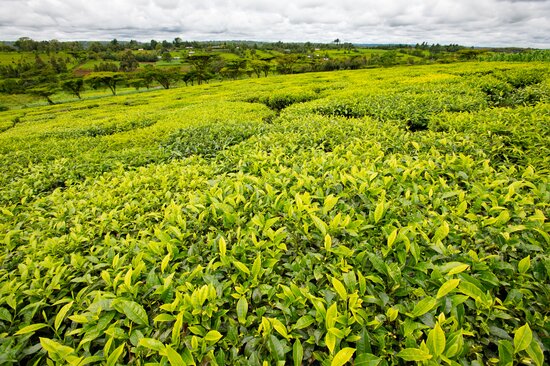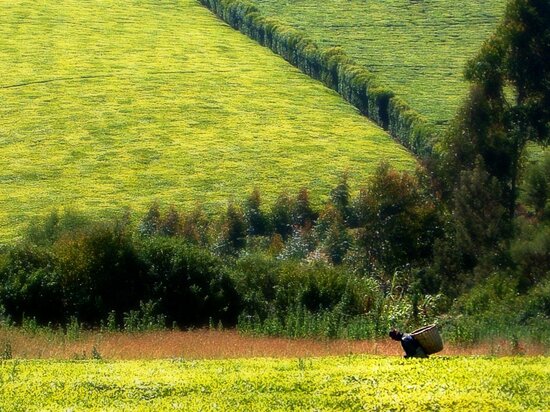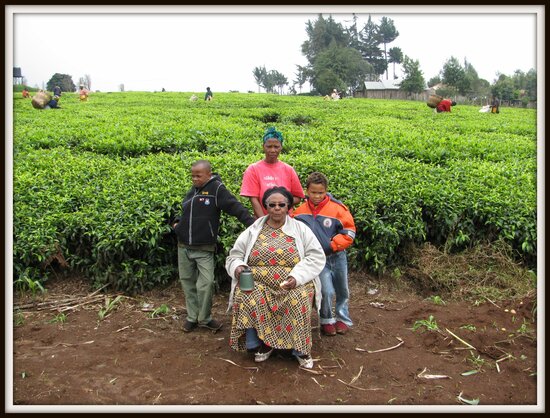Time for Tea

17 April 2019
My mother-in-law, Hilda Gathoni, has been growing tea for most of her 83 years. The same tea. The tea she and her family also drink. It’s about one and a half hectares in the highlands above the town of Limuru, less than an hour’s drive north of Nairobi, Kenya, on the edge of the Rift Valley. It was originally planted by her father-in-law in the 30s and 40s, and has paid for school fees and the odd household luxury ever since. It’s processed and packaged exclusively for export in a nearby factory; well, almost exclusively. Small-scale growers like Hilda who take their tea there can buy high-quality leaves destined for export at a discount.
The tea bushes may not have changed, but a lot of other things have. In the old days (which includes twenty years ago, when I first started having tea with her), every couple of weeks Hilda would have to go into town in her pick-up, along pretty rough roads, to get a bagful of small coins from the bank. That’s how the dozen or more itinerant pickers needed at every harvest got paid. Now they all have mobile phones and there’s M-Pesa. And the road is much better.
But the tea bushes are still the same, and, like Hilda, they’re feeling their age. Yields have been going down, and Hilda blames climate change: she says it’s getting too hot and dry for them. There are better varieties now, of course, even some unusual specialty ones, and some of the larger holders around her place have been renewing their plantations. But Hilda is attached to her tea, and has preferred to leave any uprooting and replanting that may happen to her son Mwaura, my wife Linda’s brother, who has recently taken over managing her farm.
If Mwaura does replant, and we discuss this every time I visit, it will be possible because of the work of the Tea Research Institute (formerly the Tea Research Foundation of Kenya) in Kericho, on the other side of the Rift Valley. They’ve been breeding and releasing new, improved varieties there for decades. That has in turn been possible because of all the different varieties that the institute studies and maintains on its research station, the raw material for their crop improvement work. But there has not been much exchange of material with other countries, so the diversity researchers in Kericho have at their disposal is fairly limited, and may not be able to help them cope with the problems Mwaura’s children will be facing, when they take over the farm.
According to the recently published Global Strategy for the Conservation and Use of Tea Genetic Resources, this situation is typical of the 60-odd tea-producing countries. That’s bad news for the millions of people like Hilda and Mwaura who depend on tea for their livelihoods.
The strategy was developed by scientists from the Crop Trust and the Tea Research Institute in China, in collaboration with tea programmes in eight countries, and some support from Unilever. It points out that tea conservation and breeding programmes around the world are almost exclusively nationally-focused, and there are few formal international links among them, with little safety duplication of collections and very limited movement of material. In particular, new, much-needed diversity from the areas of origin of cultivated tea between Yunnan in SW China, Assam in NE India and northern Myanmar, is just not reaching other countries. This hampers their progress in adapting to climate change, to new pests and diseases, and to changing consumer preferences.
The strategy recognises that coming to an agreement about the terms on which to exchange tea diversity will be a long-term effort. But it suggests that discussions at least need to start, perhaps using the International Treaty on Plant Genetic Resources for Food and Agriculture as a model. In the meantime, it would be useful to agree on common standards for tea conservation, and how to reach them. That includes sharing data, so that researchers in Kenya, for example, can have an idea of where around the world there might be varieties with the characteristics they are looking for.
Now that the strategy is out, the Crop Trust hopes to interest the tea industry in following the example of Unilever and support the next step, a consultation among the key tea genebanks around the world, and in particular in China and India, to start talking substantively about how to implement its recommendations. I’ve talked to Hilda about it, and she’s all for it. She wants her grandchildren, including my son, to be able to drink their own tea too.
The opinions expressed here are those of the authors and do not necessarily reflect the opinions or views of the Crop Trust. The Crop Trust is committed to publishing a diversity of opinions on crop diversity conservation and use.



